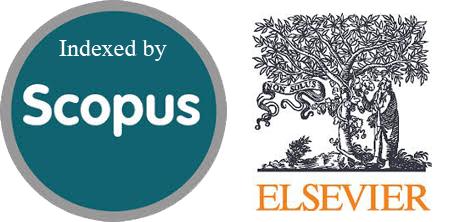Effects of Valsartan on the Gingival Architecture of Rats: Histological Study
DOI:
https://doi.org/10.54133/ajms.v8i2.1939Keywords:
Angiotensin II receptor blockers, Anti-hypertensive, Gingiva, Histology, ValsartanAbstract
Background: Valsartan is an angiotensin II receptor inhibitor prescribed to regulate heart pressure. The bulk of studies documented the impact of antihypertensive drugs on the gingival tissues; however, none have investigated the effect of valsartan on the gingival architecture. Objective: To investigate the histological effect of valsartan administration on the gingival tissue architecture in rats. Methods: Twenty Wistar male rats (2–3 months old) were randomly assigned to the control and valsartan groups. 10mg/kg/day valsartan was administered subcutaneously for two weeks. Then all the animals were sacrificed, and full-thickness samples of gingival tissue were harvested from the palatal aspect of the rat's molar teeth and prepared for examination under a microscope. Results: Although the results revealed that the valsartan group showed thicker epithelium (mean=0.1280 mm) compared to the control group, the difference did not reach statistical significance. In the lamina propria, the thickness change was statistically significant (0.07400±0.0143 mm) compared to the controls (0.0573±0.00696). The submucosa thickness measures were equivalent for both groups. The count of blood vessels showed no variation between the two experimental groups. Conclusions: Treatment with valsartan resulted in a significant increase in lamina propria thickness with no influence on epithelial thickness, submucosal thickness, or blood vessel count in rat gingival tissue.
Downloads
References
Senel S. An overview of physical, microbiological and immune barriers of oral mucosa. Int J Mol Sci. 2021;22(15). doi: 10.3390/ijms22157821. DOI: https://doi.org/10.3390/ijms22157821
Droździk A, Droździk M. Drug-induced gingival overgrowth—Molecular aspects of drug actions. Int J Mol Sci. 2023;24(6):5448. doi: 10.3390/ijms24065448. DOI: https://doi.org/10.3390/ijms24065448
Santos CF, Akashi AE, Dionísio TJ, Sipert CR, Didier DN, Greene AS, et al. Characterization of a local renin‐angiotensin system in rat gingival tissue. J Periodontol. 2009;80(1):130-139. doi: 10.1902/jop.2009.080264. DOI: https://doi.org/10.1902/jop.2009.080264
Sauer AJ, Cole R, Jensen BC, Pal J, Sharma N, Yehya A, et al. Practical guidance on the use of sacubitril/valsartan for heart failure. Heart Failure Rev. 2019;24(2):167-176. doi: 10.1007/s10741-018-9757-1. DOI: https://doi.org/10.1007/s10741-018-9757-1
Savoia C, Touyz RM, Volpe M, Schiffrin EL. Angiotensin type 2 receptor in resistance arteries of type 2 diabetic hypertensive patients. Hypertension. 2007;49(2):341-346. doi: 10.1161/01.hyp.0000253968.95136.b8. DOI: https://doi.org/10.1161/01.HYP.0000253968.95136.b8
Percie du Sert N, Hurst V, Ahluwalia A, Alam S, Avey MT, Baker M, et al. The ARRIVE guidelines 2.0: Updated guidelines for reporting animal research. PLoS Biol. 2020;18(7):e3000410. doi: 10.1371/journal.pbio.3000410. DOI: https://doi.org/10.1371/journal.pbio.3000410
Mahdi HA, Saloom HF, Kashmola MA. Effects of fixed orthodontic appliance with antihypertensive drugs on the body weight of experimental rats. J Baghdad Coll Dent. 2023;35(4):55-64. doi: 10.26477/jbcd.v35i4.3515. DOI: https://doi.org/10.26477/jbcd.v35i4.3515
Razouki N, Abdulghani B. Osteoinductive effect β-TCP and vitamin D3 on RUNX2 mRNA expression. Asia Pacific J Mol Biol Biotechnol. 2023:10-16. doi: 10.53118/apjmbb.2023.031.3.02. DOI: https://doi.org/10.35118/apjmbb.2023.031.3.02
Alanbari BF, Al-Taweel FB, Cooper PR, Milward MR. Induction of epithelial-mesenchymal transition in periodontitis rat model. Eur J Dent. 2024. doi: 10.1055/s-0044-1792011. DOI: https://doi.org/10.1055/s-0044-1792011
García‐Caballero L, Gándara M, Cepeda‐Emiliani A, Gallego R, Gude F, Suárez‐Quintanilla J, et al. Histological and histomorphometric study of human palatal mucosa: Implications for connective tissue graft harvesting. J Clin Periodontol. 2023;50(6):784-795. doi: 10.1111/jcpe.13800. DOI: https://doi.org/10.1111/jcpe.13800
Benicky J, Sánchez-Lemus E, Pavel J, Saavedra JM. Anti-inflammatory effects of angiotensin receptor blockers in the brain and the periphery. Cell Mol Neurobiol. 2009;29(6-7):781-792. doi: 10.1007/s10571-009-9368-4. DOI: https://doi.org/10.1007/s10571-009-9368-4
Rompe F, Artuc M, Hallberg A, Alterman M, StröDer K, ThöNe-Reineke C, et al. Direct angiotensin II type 2 receptor stimulation acts anti-Inflammatory through epoxyeicosatrienoic acid and inhibition of nuclear factor κB. Hypertension. 2010;55(4):924-931. doi: 10.1161/hypertensionaha.109.147843. DOI: https://doi.org/10.1161/HYPERTENSIONAHA.109.147843
Hinz B. Matrix mechanics and regulation of the fibroblast phenotype. Periodontology 2000. 2013;63(1):14-28. doi: 10.1111/prd.12006. DOI: https://doi.org/10.1111/prd.12030
Stawski L, Han R, Bujor AM, Trojanowska M. Angiotensin II induces skin fibrosis: a novel mouse model of dermal fibrosis. Arthritis Res Ther. 2012;14(4):R194. doi: 10.1186/ar4028. DOI: https://doi.org/10.1186/ar4028
Zhang Y, Zhao X, Huang H, Li M. Network meta-analysis of sacubitril/valsartan for the treatment of essential hypertension. Clin Res Cardiol. 2023;112(7):855-567. doi: 10.1007/s00392-022-02120-0. DOI: https://doi.org/10.1007/s00392-022-02120-0

Downloads
Published
How to Cite
Issue
Section
License
Copyright (c) 2025 Al-Rafidain Journal of Medical Sciences ( ISSN 2789-3219 )

This work is licensed under a Creative Commons Attribution-NonCommercial-ShareAlike 4.0 International License.
Published by Al-Rafidain University College. This is an open access journal issued under the CC BY-NC-SA 4.0 license (https://creativecommons.org/licenses/by-nc-sa/4.0/).











